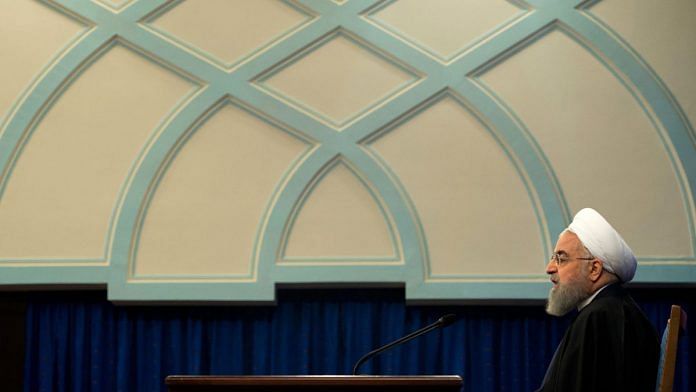If Rouhani couldn’t alleviate the country’s worsening political and economic problems during his good times, it’s unlikely he can do anything now.
Iranian President Hassan Rouhani just survived a trial-by-fire in the Iranian parliament. To Iranians and westerners looking for victories for the moderate political forces he leads, that might seem like a cause for relief.
They shouldn’t be fooled. Considering what lies ahead — three years of managing an economy debilitated by US sanctions, and of constantly being blamed for it by political enemies at home — the prospects for Rouhani and the easing of Middle East tensions he favoured have rarely been worse.
Nor should Rouhani’s survival give comfort to the Trump administration, which hopes sanctions will force Iran to negotiate for a new nuclear deal to replace the Joint Comprehensive Plan of Action that it exited in May. This is predicated on the Iranian president having the political strength to hold off hard-liners in his own country. But Rouhani, already enfeebled by President Donald Trump’s abrogation of the nuclear deal, is now a political relic.
Some Iran analysts believe that Iran is inclined to wait Trump out, putting off any re-engagement until after the 2020 US presidential election, in the hope there may be a new, more conciliatory occupant in the White House. But it might be the US that has to wait until after the 2021 Iranian presidential election — Rouhani cannot run for a third consecutive term.
Rouhani’s enervation also bodes ill for Iranians desperate for the economic and political reforms he has long promised. If he was unable to apply a stiff broom to the rotten system in the most favourable conditions — thumping election victories in 2013 and 2017 and the euphoria that followed the 2015 nuclear agreement — then it is highly unlikely that he will be able to do much now. An anti-corruption campaign is underway in Iran, but it seems directed at Rouhani rather than by him. Its most prominent victims have been his allies and appointees.
His show-trial by parliament was part of a hard-liners’ campaign to blame him for Iran’s economic problems. That he had been summoned to the legislature at all was mortifying: the only other time a sitting Iranian president was brought before lawmakers was in 2012, at the nadir of Mahmoud Ahmedinejad’s relations with the country’s political elite and its Supreme Leader, Ayatollah Ali Khamenei. Rouhani was called to explain his government’s mismanagement of the economy, and political analysts had expected him to be hauled over the coals by hard-liners who have been attacking him in every other forum.
But although he suffered ritual humiliation — the MPs voted to reject four of five answers he gave to their questions about the plummeting rial, rising unemployment, government corruption, and unchecked smuggling — his critics were uncharacteristically sparing. The strongest rebuke came from a conservative member who accused Rouhani of creating a “dream castle” of expectations over the 2015 nuclear accord, and of failing to come up with a Plan B when Trump “destroyed it with one kick.”
More tellingly, the speaker of parliament, Ali Larijani, dismissed demands that the president be sent to the judiciary for more grilling, which would potentially have opened a path to Rouhani’s impeachment.
But if Khamenei yet has use for Rouhani, it is mostly as a scapegoat. For months now, there have been sporadic protests across the country, with Iranians expressing disgust at the mismanagement of the economy, at widespread corruption, and at government spending on foreign adventures in Syria and Lebanon. Many of the protestors have aimed their slogans directly at Khamenei.
Shaken, the Supreme Leader’s first response was to serve up the hoary old chestnut that foreign enemies — his code for the US, Israel and Saudi Arabia — were using “different tools, including cash, weapons, politics and intelligence services, to create troubles for the Islamic Republic.” When the demonstrations continued, he grudgingly allowed that the protesters had legitimate grievances.
Khamenei cannot acknowledge his own enormous contribution to those grievances: his religious foundations have amassed enormous, unaccounted wealth, benefiting from as well as symbolising the official corruption that so enrages Iranians. And the ambitious, resource-draining foreign misadventures that protesters complain about are, for the most part, of Khamenei’s creation.
But Iran’s unique form of government, which gives the Supreme Leader most of the power and the president most of the responsibility, allows Khamenei to deflect blame to Rouhani, a privilege he has exercised with growing frequency as the protests have persisted. He has also cheered on the anti-corruption crackdown, much of it orchestrated by hardliners in the judiciary, which has led to scores of arrests.
Taking their cue from the Supreme Leader, hard-liners are now systematically picking off ministers from Rouhani’s cabinet. The labour minister was the first to be impeached, followed by the minister for the economy. The same fate may now befall two other members of the cabinet — the minister of education and the minister with the combined portfolios of mines, industry and business.
Talk of impeaching Rouhani himself will now cool after the speaker of parliament blocked that path. Since Larijani is a creature of the Supreme Leader, it appears that while Khamenei is happy to make sacrificial lambs of his ministers, he still needs his president as a whipping-horse. But Rouhani is of no use for anything — or to anyone — else. – Bloomberg







Very unfortunate. Who could have expected ” a single kick “ when the P 5 + 1 signed a patiently negotiated agreement with Iran to halt its nuclear programme. Bob Woodward’s book and the anonymous Op Ed in the NYT show how the Trump administration is working. Iran should be patient, wait for a return to normalcy. In the meantime, it could set its internal house in order.